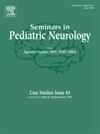Congenital toxoplasmosis
IF 2.1
4区 医学
Q2 CLINICAL NEUROLOGY
引用次数: 0
Abstract
Toxoplasma gondii, one of the most prevalent zoonotic parasites globally, may be transmitted to the fetus if a primary infection occurs during pregnancy. The earlier the gestational period, the lower the probability of transmission, but if it occurs, the higher the probability of pregnancy loss or severe fetal neurological or ocular damage. Primary prevention measures to pregnant women include avoiding eating or handling raw or undercooked meat, washing hands thoroughly after gardening, avoid handling contaminated soil or water or come in contact with cat feces. The infected fetus may exhibit a broad spectrum of clinical manifestations, ranging from death in utero, stillbirths, symptomatic neonatal forms with systemic involvement and/or severe and irreversible ocular or neurological damage, to asymptomatic forms. Neurological manifestations include macro- or microcephaly, hydrocephalus, intracranial calcifications, abnormal muscle tone, cerebral palsy, global developmental delay, sensorineural hearing loss, and epilepsy. The whole clinical picture of each patient with congenital toxoplasmosis depends on a variable combination of different factors including: (a) gestational age at which the maternal infection has occurred and transmitted to the fetus, (b) disease detection: were pregnant women systematically screened during pregnancy, and if so, the frequency of serological tests, (c) if infected pregnant women and neonates were treated and timing and doses of the anti-T. gondii drugs used, (d) differences in the parasite load and in virulence of the genotype of the implicated T gondii strains, (e) individual maternal immune response, and f) presence of specific clinical features such as ventriculomegaly, multiple calcifications and retinochoroiditis.
先天性弓形体病
刚地弓形虫是全球最流行的人畜共患寄生虫之一,如果在怀孕期间发生原发性感染,可能会传播给胎儿。妊娠期越早,传播概率越低,但一旦发生,流产或严重胎儿神经或眼部损伤的概率就越高。孕妇的初级预防措施包括避免食用或处理生肉或未煮熟的肉,在园艺后彻底洗手,避免处理受污染的土壤或水或接触猫的粪便。受感染的胎儿可能表现出广泛的临床表现,从宫内死亡、死产、全身受累和/或严重且不可逆的眼或神经损伤的新生儿症状,到无症状形式。神经学表现包括大头或小头畸形、脑积水、颅内钙化、异常肌张力、脑瘫、整体发育迟缓、感音神经性听力损失和癫痫。每个先天性弓形虫病患者的整个临床情况取决于不同因素的可变组合,包括:(a)母体感染并传播给胎儿的胎龄;(b)疾病检测:孕妇在怀孕期间是否进行了系统筛查,如果是,血清学检测的频率;(c)感染的孕妇和新生儿是否接受了治疗,以及抗t抗体的时间和剂量。使用的弓形虫药物,(d)涉及弓形虫菌株基因型的寄生虫载量和毒力差异,(e)个体母体免疫反应,以及f)存在特定的临床特征,如心室肿大、多发性钙化和视网膜脉管炎。
本文章由计算机程序翻译,如有差异,请以英文原文为准。
求助全文
约1分钟内获得全文
求助全文
来源期刊

Seminars in Pediatric Neurology
CLINICAL NEUROLOGY-PEDIATRICS
CiteScore
4.80
自引率
0.00%
发文量
38
审稿时长
84 days
期刊介绍:
Seminars in Pediatric Neurology is a topical journal that focuses on subjects of current importance in the field of pediatric neurology. The journal is devoted to making the status of such topics and the results of new investigations readily available to the practicing physician. Seminars in Pediatric Neurology is of special interest to pediatric neurologists, pediatric neuropathologists, behavioral pediatricians, and neurologists who treat all ages.
 求助内容:
求助内容: 应助结果提醒方式:
应助结果提醒方式:


